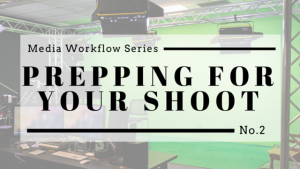Welcome to post 2 of our Media Workflow series. This week, We’ll review the steps you should take to prepare for your shoot:
1. Charge Batteries:
This is a crucial part of preparation. It is easier to keep batteries charged when shooting indoors, such as in the media commons video studio. If you must bring equipment with you that will not be plugged in during the shoot, make sure that any batteries are fully charged beforehand. This includes camera batteries and audio equipment such as lavalier microphones and recorders. Some batteries take longer than others to charge, so be sure to leave ample time. Bring spare batteries if possible.
2. Format Media:
It is important to clear off media that is stored on an SD or SSD card before beginning your shoot. This makes space on the card so that you have maximum storage for your new video. Most devices have an option in the settings menu to “Format Media” – always do this before beginning a shoot. Any important media should be exported and backed up before formatting.
3. Determine Camera Settings:
ISO
This controls the amount of digital “brightness” that is added to your recording. Generally speaking, try to set this as low as possible while still maintaining adequate light exposure in your shot
Aperture
Generally speaking, you want to shoot at the widest Aperture possible. This will give you the most light and allow you to keep ISO low. However, you may need to “stop-down” your aperture in bright conditions (such as the outdoors) to let in less light by increasing the f-number (usually ranges from f1.8, f2.8 or f3.5 at the most open to f24 at the most closed). Beware that some zoom lenses have different maximum aperture settings at the two ends of their zoom (i.e. f3.5 at the widest setting and f5.6 at the most zoomed). In this situation, if you will be zooming during your recording, set the aperture to the higher f-number (f5.6 in this scenario)
One last thing to be aware of, is that the more open your aperture is the narrower the “plane of focus” will be. This means that at low f-numbers (~f3.5 and below), the camera will only be able to keep things in focus at the same time that are the same distance from the camera. For a deeper “plane of focus” (to keep more of the depth of your frame in focus at th same time) increase your f-number
Frames per second (FPS)
This is how many images the video camera records each second. Normally, video is shot at 24 fps (23.98 fps more specifically). This mimics the motion blur that the human eye sees when objects are moving quickly
If you want to record slow-motion footage, you’ll need to shoot at a higher frame rate; so that you still maintain at least 24 fps when you slow it down (i.e. 60fps slowed down by 50% = 30 fps). Our GoPro cameras are great for this!
ALWAYS MAKE SURE ALL FOOTAGE FOR THE SAME PROJECT IS SHOT AT THE SAME FRAME RATE
Resolution
You will have a choice of shooting in 1080p, 720p (and maybe even 4K!) on our cameras. These are the pixel sizes of the video files (how large the video is on your screen). Currently, most video uploaded to YouTube, Vimeo or Kaltura is transcoded to 720p to make streaming more smooth. However, we recommend shooting in 1080p, because you can always make the video smaller later, but trying to enlarge video will result in a blurry effect.
You will also be able to crop your video when shooting in 1080p. You are able to choose just a portion of your video and effectively re-frame your shot during post-production (potentially cropping out something you didn’t mean to be in the frame!)
If using multiple cameras, try to use the same model and keep your settings the same (with possible changes in aperture/ISO depending on the lighting conditions where each camera is facing)

